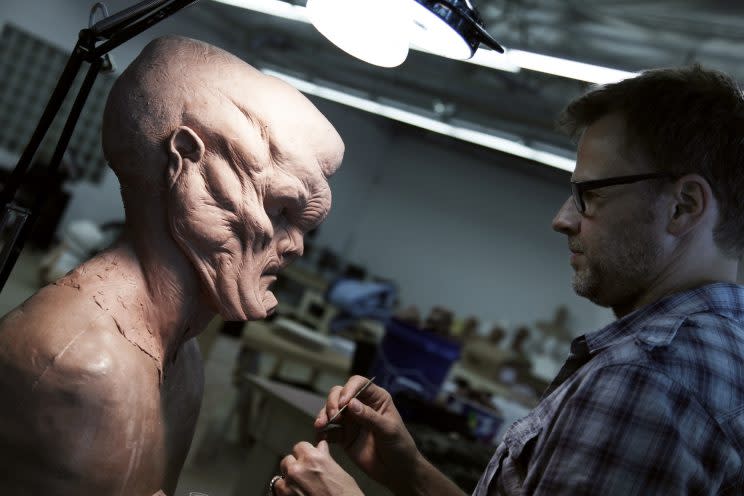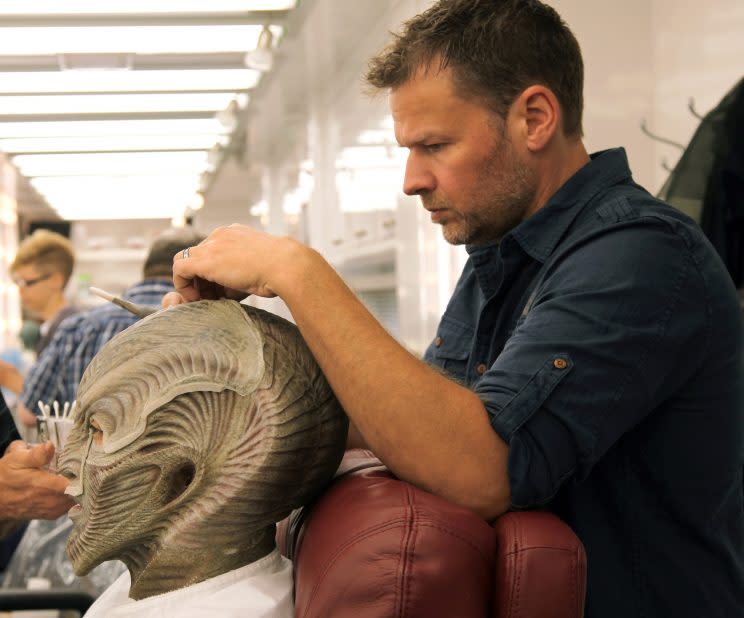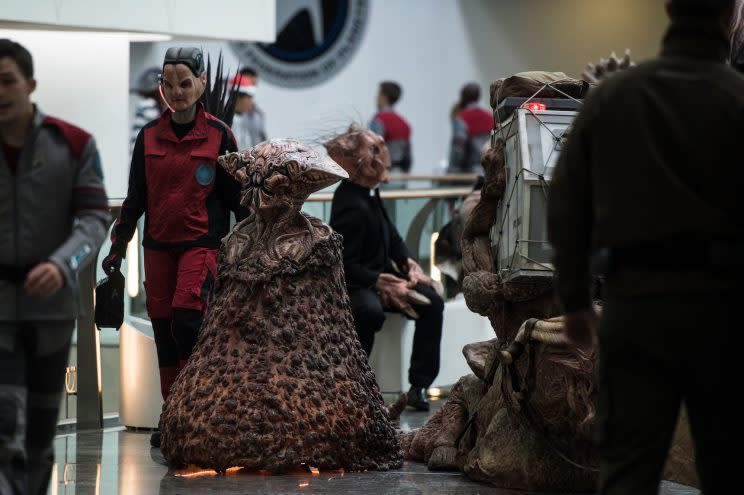Oscar-Nominated Makeup Whiz Joel Harlow on Crafting ‘Star Trek Beyond’ Aliens, Marvel Superheroes, and Johnny Depp Disguises

For 30 years, Joel Harlow has been one of Hollywood’s premiere makeup artists, and come Oscar night, he’ll contend for his second Academy Award for his work on Star Trek Beyond, which required him to create more than 50 different alien species. A North Dakota native, Harlow took home a gold statuette for J.J. Abrams’s 2009 Star Trek reboot, and also received a nomination for 2013’s The Lone Ranger — one of his 16 collaborations with Johnny Depp. (Over the weekend, Harlow scored the Makeup Artists Guild Award for Best Makeup Effects for his Beyond work.)
Adding to a résumé full of blockbuster credits, Harlow will next put his talents to use for two upcoming superhero films — this March’s Logan, and next year’s Black Panther — as well as Depp’s fifth go-round as Captain Jack Sparrow in this summer’s Pirates of the Caribbean: Dead Men Tell No Tales. Before any of those hit theaters, however, he spoke with us about the challenges of Star Trek Beyond, operating within the Marvel Cinematic Universe aesthetic, and his fondness for HP. Lovecraft.
First — congratulations on your Oscar nomination for Star Trek Beyond.
Thank you!

You previously won an Oscar for 2009’s Star Trek, were you a big Star Trek fan growing up?
Absolutely. I remember watching the original series in reruns as a child in Denver, Colorado, where my father and mother were born, and where we’d vacation from North Dakota every summer and every Christmas. My first memory of Star Trek is sitting in my grandmother’s house watching the original episodes on her old TV. So yeah, I was absolutely a fan as a child. It’s so much a part of those vacations and that sort of childhood experience, it’s impossible for me to separate the two.
Related: New Director! New Aliens! New Set! Secrets From the Star Trek Beyond Set
Was that fondness for the franchise how you first became involved with the new films?
It was a fluke! It was a very lucky coincidence, and came out of the blue for me. I was called by a friend of mine to help in his studio building and designing aliens for the 2009 Star Trek. Ultimately, what I became was sort of the point man on-set for him, where I would take the prosthetics that they were still building in the shop, and I’d manage everything on set.
There were some problems back at the shop with some of the prosthetics that were being turned out. I had done the Pirates films previous to this, and [unit production manager] Tommy Harper and [executive producer] Jeffrey Chernov knew that, and thus came to me and asked me if I wouldn’t mind sort of running it.

We were still figuring out two races — the Romulans and the Vulcans — and they asked me if I wouldn’t mind running the department for those two races, like I did on Pirates. Which means I set up, internally, a makeup effects lab that was also a makeup effects application department. I said, “Yeah, I’ll do that,” and then my friend continued to build the background aliens, and I took over the Vulcans and designed the Romulans. We just started making and testing them there on the Paramount lot, and ultimately, we found the look that J.J. [Abrams] liked, and we ran with it.
This year was the 50th Anniversary of the Star Trek franchise. Were there any ways in which you tried to pay homage to the series’ history in Star Trek Beyond?
Certainly. Being a fan, I wanted to deliver something to the fans, like myself, that they’d never seen before in a Star Trek film. There have been dozens and dozens of wonderful alien characters in the Star Trek franchise, so we wanted to give them something more because it was the 50th anniversary. And not just a little bit more — a LOT more, in terms of quality, hopefully, and also quantity as well. So we wound up building 56 different alien species for the film.
Related: Star Trek — The Stealth Musical?!
But as far as revamping traditional alien designs from the original series or the films? We started going that route, but it’s like reliving your favorite memory. You can’t do it. So the closest we came to revamping a design from the originals is, there’s a little bit of Klingon influence in [Idris Elba’s] Krall, which sort of works for his character, because he’s an amalgam of all the biological material of the various alien races that he’s gotten his hands on, and has drained, to keep himself alive. There’s a nod to Klingon in him, but it’s not overt by any means. That’s as far as we went in the design phase, in reproducing traditional Star Trek aliens.

Of those 56 different alien races, did you have a particular favorite?
They all were! I know that sounds like an easy-out answer, but it’s true. They were all my favorites, because they all had something about them that pulled me to each one of their alien designs. They were all extremely difficult to accomplish, but no two of them are the same. So even if you’re using the same materials and techniques, you have to redesign your thought process when it comes to breaking down a sculpture.
We tried really hard to make sure each one was its own character, and not to borrow from any other characters. That would have been too easy. Because, say, you’ve got 15 different versions of an ear sitting around — it would have been too easy to take this alien’s ear and use it on that alien. That would have felt like a cheat, and that’s what we were trying not to do, especially for the anniversary.

How closely do you work with the actors themselves, in terms of crafting their particular looks? Is that especially important with lead actors like Idris Elba on Star Trek Beyond?
Yes, and Idris had a lot of input into the stages of the various looks of Krall. You can’t ignore the actor. If you do, what you’re going to wind up with is a nice photograph, not a performance. The actor has to be an integral part of the creation of that character, because ultimately they’re the ones that bring life to it. You can spend months and months in the shop, as we did, giving your best sculpting, your best molding, your best casting, your grandest ideas as far as how to create something unusual and unique. But unless that character can perform and that sculpture can come to life, and that paint job can move and live, all you have is a still frame.
Fortunately on this film, all of the performers were fans of Star Trek as well. And because we had everybody giving 110 percent, everything worked. It’s surprising, because especially with a film that involves this many practical makeups, there’s always something that goes wrong. There’s always somebody that’s going to complain, and say, “I didn’t know I was going to look like this, I didn’t know they were going to turn me into a werewolf,” whatever it is. But we had none of that on this film, and I attribute that to everybody loving Star Trek.

Is it easier to do something like Star Trek Beyond, or a drama like Black Mass, where you have to create a more reality-based effect?
It is a different approach. Doing something like Black Mass is very precise in a way that doing a Star Trek Beyond isn’t. Star Trek Beyond allowed for a lot of creativity, and allowed for a lot of imagination to come into play. It allowed for a lot of testing and use of materials that had never been used in makeup before, because we were trying to push the envelope.
When you’re dealing with something like Black Mass, you’ve got a very recognizable performer [Johnny Depp] playing a fairly recognizable real-life person [James “Whitey” Bulger], so there’s no margin for error. It can be stressful, as far as achieving and maintaining that look. Certainly Star Trek is stressful because you’re achieving and maintaining 56 different looks [laughs], but yeah, it’s a different approach. We were creating a human being as opposed to a humanoid alien.
Are there specific films you remain particularly proud of, or helped teach you something that you’ve found useful on subsequent jobs?
I think I’ve learned at least one thing on every project I’ve been on, and certainly in the beginning. The character of Bootstrap Bill in the Pirates films [played by Stellan Skarsgård] — it hasn’t really gone under the radar, but that makeup is still one of my favorites that I’ve done. I’m a big fan of the ocean, as you can kind of see in some of the designs for the Star Trek Beyond background aliens. That character brought together those elements that I love about the deep sea and pirates and all that, all at the same time. I did all the makeup on Stellan Skarsgård, who’s amazing, and for the Stage 6 makeup I put him in, it took us about seven hours to apply. He was rock-still through the whole thing — and I was gluing right up to his lash line.

I love the Pirates films, and I always found Davey Jones’s crew very interesting. Bootstrap was the only practical makeup out of all of them, and I got to design how that one came together, and sculpt and apply it through the six stages over two films.
Any type of project you’d most love to work on?
It’s H.P. Lovecraft! It’s all Lovecraft. Maybe that’s part of the reason I love that Bootstrap Bill makeup so much, is that Lovecraft was very influenced by things aquatic — tentacles, webbed stuff, fish people and that sort of a thing. When I’m not working, more often than not, you can find me sculpting some human-fish hybrid in my studio in Van Nuys just for fun. Going back to my trips to Denver, Colorado, my father and I would walk down Colfax Avenue and I would duck into all the used bookstores looking for anything by Lovecraft. That became part of the treasure hunt.
Those days are now over; all I’d have to do is go on Amazon. You don’t have to hunt for anything. But back then it was fun, to sift through these dusty piles of old paperbacks and try to find something with an interesting cover that sparked the imagination.
We’ve got to get you together with Guillermo del Toro, who for years has wanted to adapt Lovecraft’s At the Mountains of Madness.
He’s the one that could do it too! He’s a fan. It’s funny you say that, because a friend of mine just put me in touch with him. But you know, you don’t want to come across as “Hey, I want to do your movie!” So my email to him was fairly benign and just full of appreciation, from one Lovecraft fan to another.
You recently finished work on Logan, and you’ve been working on Black Panther and Pirates of the Caribbean: Dead Men Tell No Tales. Is it tough seguing between such different types of movies?
It is a little bit. Working on Logan — that was the first of my superhero films. Then I segued onto Black Panther, which is another superhero film. It’s certainly much different than any of the other films I’ve done. But each film has its own challenges and its own rewards. Whether it’s a big budget, small budget, whatever, the only thing that attracts me to projects is the opportunity to create interesting characters. I’m really just still a kid from North Dakota wanting to make monsters in the basement. If somebody gives me that opportunity and says they’ll put it on the screen, I’ll jump at it.
What’s made Black Panther such a challenge?
I can’t talk too much about it. It’s just fitting into the aesthetic. The Marvel Cinematic Universe has a very defined aesthetic, and working in that aesthetic can be a little challenging. But filmmaking in and of itself is challenging, and they’re all challenging.
With regards to Pirates, you’ve worked with Johnny Depp on numerous projects. What is it about him that makes your collaboration such a lasting one?
He’s a fan of transformational makeup. He takes chances that not a lot of people take, as far as changing his appearance to fully become a character. I really appreciate that. He speaks the language of makeup, so at this point, we have a shorthand. I know what he means when he throws out makeup phrases, and I can hopefully tackle them in the lab and then apply the finished pieces to him in the way he was thinking. It’s that, more than anything else — he changes himself. He uses all the tricks of filmmaking — be it props, hair, makeup, wardrobe, environment, whatever it is — to fully become a character.
A lot of the time, it’s risky. But without risk, there’s no real payoff.

Is it tough continuing to find new ways to be inventive and fresh on a fifth Pirates film, as opposed to a brand new project?
Well, I didn’t department-head Pirates 5, because I was doing Star Trek Beyond at that time. But I did end up department-heading the additional photography up in Vancouver, which was about a month’s worth of work. That was difficult, just because I hadn’t designed anything. I took somebody else’s designs and I was executing those. You always look at it and say, “I would have done this differently, I would have done that differently.” What they ended up doing was great — it was really nice stuff. But for me, I like to design it, sculpt it, build it, and then apply it, because that’s the sort of Frankenstein syndrome: You put your monster together, and then you see it come to life. Putting somebody else’s monster together and seeing it come to life is still fun, but you don’t get the same sense of accomplishment you do when you were there at the beginning.
Read more:

